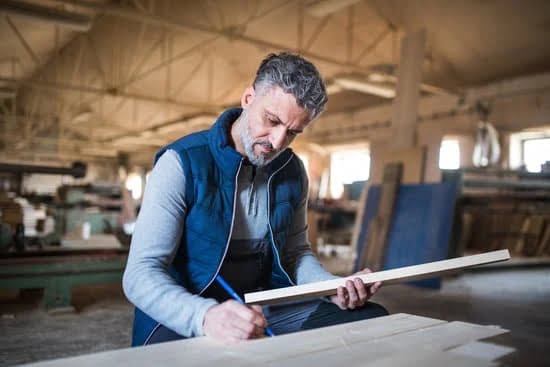Woodworking indoors offers a convenient and comfortable way to pursue one’s passion for woodworking regardless of the weather or outdoor conditions. In this article, we will explore the benefits and advantages of woodworking indoors, as well as the different types of projects that can be accomplished within the confines of an indoor space. Whether you are a beginner or an experienced woodworker, there are numerous opportunities to create stunning pieces right in the comfort of your home or workshop.
One of the key advantages of woodworking indoors is the ability to work in a controlled environment, free from external factors such as rain, wind, or extreme temperatures. This allows for greater precision and focus when working on intricate projects. Additionally, indoor woodworking provides the flexibility to pursue your craft at any time, making it a suitable option for those with busy schedules or limited outdoor space.
When it comes to indoor woodworking projects, the possibilities are vast. From small decorative items to larger furniture pieces, there is no shortage of creative avenues to explore. Whether you prefer hand tools or power tools, there are plenty of options for indoor projects that cater to various skill levels and interests. As we delve into this article, we will discuss essential tools and equipment for indoor woodworking and provide tips on choosing the right indoor workspace for your projects.
Essential Tools and Equipment for Indoor Woodworking
When it comes to woodworking indoors, having the right tools and equipment is essential for a successful and enjoyable experience. Whether you are a beginner or an experienced woodworker, having space-saving and efficient tools can make all the difference in creating beautiful and functional indoor projects. Here are some essential tools and equipment recommendations for woodworking indoors:
- Compact Table Saw: A compact table saw is perfect for indoor woodworking due to its space-saving design. Look for one with a sturdy tabletop and precise cutting capabilities.
- Folding Workbench: A folding workbench is a great addition to any indoor workspace as it can be easily stored when not in use, providing flexibility in limited spaces.
- Cordless Drill: A cordless drill offers convenience and maneuverability for indoor woodworking projects. Look for one with interchangeable batteries for continuous use.
- Router with Dust Collection: A router with built-in dust collection is ideal for indoor use as it helps control the sawdust and debris, keeping your workspace clean and safe.
In addition to these essential tools, quality hand tools such as chisels, hand planes, and clamps are also necessary for fine detail work in indoor woodworking. Investing in high-quality tools that are designed for indoor use can help you create precise and professional-looking projects without taking up too much space.
When setting up your indoor workspace, it’s important to consider the layout of your tools and equipment to maximize efficiency. Proper storage solutions such as wall-mounted tool racks and compact tool chests can help keep your workspace organized and clutter-free. With the right tools and equipment, woodworking indoors can be a rewarding and fulfilling hobby or profession.
Choosing the Right Indoor Workspace
When it comes to woodworking indoors, finding the right space is essential for a successful and enjoyable experience. Whether you have a dedicated room or just a corner in your home, there are several tips for setting up an indoor workspace for woodworking. One of the key considerations is ensuring that the area is well-ventilated, especially when working with wood dust and finishes. Having proper ventilation can help maintain air quality and reduce health risks associated with woodworking indoors.
Maximizing limited indoor space for woodworking projects is also important. Consider incorporating space-saving storage solutions, such as wall-mounted tool racks and shelves, to keep the area organized and efficient. Additionally, utilizing multifunctional furniture or workbenches with built-in storage can help make the most of your indoor woodworking space.
Another factor to consider when choosing the right indoor workspace for woodworking is access to natural light. Adequate lighting is crucial for precision and safety when working on intricate projects. If natural light is limited, investing in quality task lighting or adjustable lamps can provide the illumination needed for detailed work.
In addition to these practical considerations, creating a comfortable and inspiring environment in your indoor woodworking space can contribute to overall enjoyment and productivity. Adding personal touches, artwork, or plants to the area can make it a welcoming and creative place to pursue your woodworking passion.
| Indoor Woodworking Tips | Recommendations |
|---|---|
| Proper Ventilation | Invest in a good quality dust extractor or install a ventilation system. |
| Maximizing Space | Utilize wall-mounted tool racks and multifunctional furniture for efficient use of space. |
| Natural Light | Ensure access to natural light or invest in quality task lighting for detailed work. |
| Creative EnvironmentAdd personal touches like artwork or plants to create an inspiring workspace. |
Safety Precautions for Indoor Woodworking
When engaging in woodworking indoors, it is important to prioritize safety to ensure a secure and healthy environment. One of the primary considerations for indoor woodworking is proper ventilation. Since indoor spaces are more confined, the accumulation of wood dust and fumes from finishes can pose a health hazard if not managed effectively.
It is advisable to invest in high-quality dust collection systems and air filtration units to maintain good air quality while working on projects indoors. Additionally, wearing a dust mask and protective eyewear can help minimize exposure to airborne particles during the woodworking process.
Another crucial safety precaution for indoor woodworking is the implementation of effective dust control measures. Wood dust not only presents health risks but also creates a fire hazard due to its combustible nature. To mitigate these risks, it is essential to keep the workspace clean and free from excessive sawdust accumulation. Regular vacuuming and sweeping, as well as the use of dust extraction attachments on power tools, can aid in controlling the spread of wood dust in indoor environments.
Furthermore, proper handling and storage of hazardous materials such as adhesives, solvents, and finishes are vital safety considerations for indoor woodworking. These substances should be kept in well-ventilated areas away from sources of ignition and heat. It is also important to follow manufacturer instructions for the safe usage and disposal of these materials to prevent accidents or environmental harm.
| Safety Precautions | Indoor Woodworking |
|---|---|
| Ventilation | Invest in high-quality dust collection systems and air filtration units |
| Dust Control | Maintain good air quality by wearing a dust mask, using protective eyewear, regular vacuuming, and sweeping |
| Hazardous Materials | Appropriate handling and storage of adhesives,solvents,and finishesare essential. |
Indoor Woodworking Techniques and Projects
Woodworking indoors offers a wide range of possibilities for creative projects, whether you have a dedicated workshop or just a small corner of your home to work in. With proper planning and the right tools, you can create beautiful and functional items right in the comfort of your own home. From smaller craft projects to larger furniture pieces, there are plenty of techniques and projects to explore within the confines of indoor space.
Techniques for Indoor Woodworking
When working on woodworking projects indoors, it’s important to consider the noise and dust levels that may affect others in your home. As such, hand tools that produce less noise and minimal dust are ideal for indoor use. Hand saws, chisels, hand planes, and carving tools are great for intricate and detailed work while producing minimal disturbance.
Indoor Woodworking Project Ideas
There are numerous indoor woodworking project ideas to choose from that cater to different skill levels. For beginners, small-scale projects like wooden picture frames, cutting boards, or decorative shelves are easy and practical choices. For more experienced woodworkers with adequate space, larger projects such as side tables, storage boxes, or even indoor plant stands can be undertaken. Regardless of skill level or available space, there are indoor woodworking projects suitable for anyone looking to engage in this rewarding hobby.
Creative Use of Limited Space
For those with limited space for indoor woodworking, it’s essential to be creative with organization and storage solutions. Utilizing wall-mounted tool racks and compact workbenches can maximize floor space while keeping essential tools easily accessible. Additionally, considering multi-functional furniture pieces that also serve as storage units can help keep your indoor workspace clutter-free yet functional.
Incorporating sustainable and reclaimed materials into indoor woodworking not only adds an eco-friendly aspect but also provides an opportunity to create unique and visually appealing pieces. By sourcing environmentally-friendly wood materials from local suppliers or utilizing reclaimed lumber from old furniture or shipping pallets, woodworkers can contribute to sustainability efforts while adding character to their indoor woodworking projects.
Whether through intricate detailing on small-scale items or through larger furniture pieces with historical significance, using sustainable materials adds depth and meaning to each project.
Incorporating Sustainable and Reclaimed Materials in Indoor Woodworking
Woodworking indoors offers the opportunity to create beautiful and functional pieces while staying comfortable inside your home. One of the ways to make indoor woodworking even more rewarding is by incorporating sustainable and reclaimed materials into your projects. Not only does this approach help reduce waste, but it also adds character and uniqueness to your creations. Below are some tips for integrating eco-friendly materials into your indoor woodworking projects:
- Reclaimed Wood: Salvaged or reclaimed wood from old furniture, buildings, or shipping pallets can be repurposed for new projects. Look for interesting textures, colors, and grains that add a rustic or vintage charm to your indoor woodworking pieces. Consider using reclaimed wood for items such as shelves, picture frames, or small furniture.
- Sustainable Hardwoods: When purchasing new wood for indoor woodworking projects, opt for sustainably sourced hardwoods that are certified by organizations like the Forest Stewardship Council (FSC). These woods come from responsibly managed forests, ensuring that future generations will continue to enjoy them. Look for FSC-certified options in popular species like maple, oak, cherry, and walnut.
- Eco-Friendly Finishes: Choose environmentally-friendly finishes and stains to protect and enhance your indoor woodworking creations. Water-based finishes are a great option as they emit fewer volatile organic compounds (VOCs) compared to traditional oil-based products. Additionally, explore natural options like beeswax or plant-based oils to give a beautiful and non-toxic finish to your projects.
By incorporating sustainable and reclaimed materials into your indoor woodworking endeavors, you can create unique pieces while contributing positively to the environment. Whether you’re a beginner or a seasoned woodworker, experimenting with eco-friendly materials adds an extra layer of creativity and satisfaction to your craft. Moreover, using sustainable materials aligns with the growing trend of conscious consumerism in the woodworking community.
Maintenance and Care for Indoor Woodworking Space and Tools
Maintaining a clean and organized indoor woodworking space is essential for both efficiency and safety. One of the key aspects of this is keeping the area free from dust and debris, as woodworking indoors can create a significant amount of sawdust and shavings.
Regular vacuuming and dusting of the workspace, as well as investing in a high-quality air filtration system, can help to keep the area clean and reduce the risk of respiratory issues associated with prolonged exposure to wood dust.
In addition to keeping the workspace clean, it is important to properly maintain and care for indoor woodworking tools and equipment. This includes regular sharpening of cutting tools such as chisels, planes, and saw blades, as well as oiling or waxing metal components to prevent rust and corrosion. Keeping blades sharp not only improves the quality of woodworking but also reduces the risk of accidents that can occur when using dull tools.
Proper storage is also crucial for maintaining the longevity of indoor woodworking tools. Storing them in a dry environment away from moisture helps to prevent rust, while organizing them on racks or tool chests can make it easier to locate specific tools when working on a project. By establishing good habits for maintenance and care, indoor woodworking enthusiasts can ensure that their tools and space remain in optimal condition for years to come.
Inspiration and Resources for Indoor Woodworking
In conclusion, woodworking indoors offers a multitude of benefits and advantages for enthusiasts. From the convenience of being able to work on projects regardless of the weather, to the ability to create in a comfortable and controlled environment, indoor woodworking opens up a world of possibilities. With the right tools, workspace, safety precautions, and materials, individuals can explore their creativity through various woodworking techniques and projects.
When it comes to finding inspiration and resources for indoor woodworking, there are plenty of avenues to explore. Whether it’s browsing through books and websites dedicated to woodworking, joining online communities to connect with fellow enthusiasts, or simply taking a stroll through nature for ideas, the options are endless. The wealth of information available also extends to sourcing sustainable and reclaimed materials for environmentally-friendly projects, further adding depth and purpose to indoor woodworking endeavors.
Ultimately, woodworking indoors allows individuals to not only hone their skills but also express their creativity in a space that is tailored to their needs. By prioritizing maintenance and care for both the workspace and tools, enthusiasts can ensure that their indoor woodworking area remains functional and organized for future projects. With the right mindset and resources at hand, indoor woodworking becomes an enriching hobby that can be enjoyed year-round.
Frequently Asked Questions
Can You Do Woodworking Indoors?
Yes, woodworking can be done indoors as long as there is enough space and proper ventilation. It’s important to have the right tools, such as a dust collection system, to minimize the mess and keep the area clean.
Can I Do Woodworking in My Basement?
Woodworking in a basement can be a great option, especially if it provides enough space and access to power outlets. However, it’s crucial to consider ventilation, dust control, and noise for a comfortable working environment.
How Do You Have a Workshop When You Live in an Apartment?
Having a workshop in an apartment requires careful planning and consideration for noise and space limitations. Portable tools and workbenches can be helpful for creating a compact yet functional workspace. Additionally, using hand tools or seeking out communal workshops can also be viable options for apartment dwellers.

Hi everyone! I’m a woodworker and blogger, and this is my woodworking blog. In my blog, I share tips and tricks for woodworkers of all skill levels, as well as project ideas that you can try yourself.




